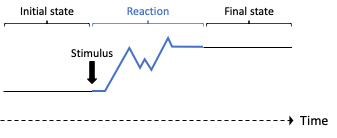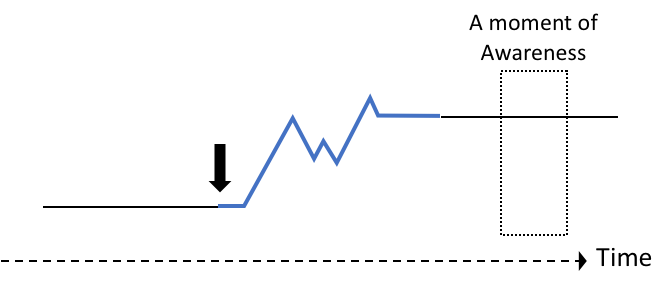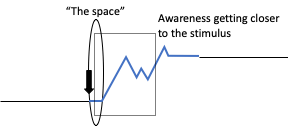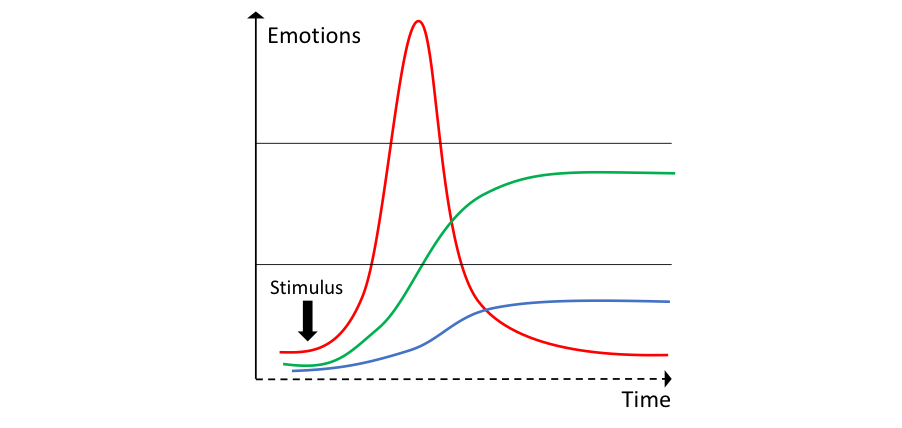
I am fascinated by consciousness. What is it? What’s its purpose? Is it generated in the brain, or not? I’ve also been fascinated by its exploration. Getting access to it in the corners of my mind and my body. Getting access and deepening consciousness is an embodied experience.
And for me, it all started with self awareness.
I use the word “awareness” here to refer to as our inner abilities to watch what is happening in our mind and body. It can be thoughts, basic body feelings, emotions, sense perceptions, behaviour, and how these aspects might be caused or correlated with each other in time, and with external stimuli from our environment.
Let’s get a bit graphical here with the figure below showing how the inner state of our body-mind combined with the state of our external environment changes over time around a stimulus.
- A stimulus can be either external, e.g., your boss telling you something, your girlfriend behaving in a certain way, the smell of flowers, or internal, e.g., a thought, an emotion, or a body feeling such as a light nausea.
- In the context of this post, we only consider stimuli that are not life threatening, i.e., whatever your reaction to the stimulus (or non-reaction altogether), you survival is not at risk.
- A reaction here is also considered to be internal and/or external, i.e., your inner thoughts or emotions, and your behaviour, resulting in the final state.

On this picture I drew an “unconscious” reaction (you will understand later why), i.e., which occurs when we don’t have any clue in our normal waking consciousness of what’s actually happening. We might even not be aware at all of the initial stimulus. We are not aware of our reaction to it, or of the way our reaction actually impacts ourselves inwards, or outwards on people around us. In that case, it is a complete automatic chain of events we actually have no clue about.
A lot of people spend most of their time in such complete unconscious state, and oblivious of what is constantly happening in the present moment of their daily lives. They firmly believe that their thoughts, emotions, and fears, completely and totally define who they are.
Unconsciousness also manifests in people constantly drawn in their inner chatter. It is an addiction to thinking. They spend most of their time in their head, oblivious of what’s happening in their body. I was one of them. Completely addicted to my own constant inner mental ruminations. Thoughts and worries jumping all around my mind at speed light, without challenging their truthfulness.
So now, on the following chart, let’s introduce a short window of awareness. As already mentioned, by awareness here, I simply mean our inner capabilities to be mindful of what’s happening in the present moment, in our body and mind. And from this short window of awareness, we might notice how we are feeling. It might be anxiety, anger, or joy. We might notice that we are overthinking, that we are pissed by the guy talking to us, or that we feel tension in our upper back.

At that stage, we still don’t have any clue of what might have led us to what we are feeling, but it is a first great step.
Bringing consciousness in the present moment.
We start to pay attention. To become the observer of what’s happening inside us.
It is a great step forward, but unfortunately most likely very time limited. Sometimes, just after a couple of breaths, this short window of awareness just vanishes. Dissolved again in the chaos of our unconscious inner-chatter.
And so, that’s how my real practise began. Initially very influenced by Eckhart Tolle’s perspective.
I already talked about in this post how I have been practicing and increasing my awareness in the last years, and how I felt depressed for two weeks when I initially decided to commit on the long run to this inner awakening process. Indeed, my commitment to this work encompassed at the beginning to start letting go of my constant over-thinking patterns. I needed to think less and feel more what was happening in my body.
I had a hard time letting go because if I was actually not the anxious over-thinker that I had known to the bones for so many years, who was I then?
I fully committed to the practice of widening windows of awareness in my daily life. Watching my body feelings and thoughts. Watching without being completely identified by them. Trying not to fuel them when it was not necessary. Watching the constant inner voices keeping analyzing the past or worrying about the future, most of the time as a useless, heavily self-centered, repetitive noise. And increasing moments of “no-mind” in which mind-focused analytical thinking is replaced by a gentle body-focused awareness, without the need to judge, name or label things, or conceptualize the present moment of what is. Not only did I commit to have longer windows of awareness, but also to have more of them throughout my days.
And as I already described, I believe that my commitment to increase awareness in the present moment has been a key element towards becoming a more conscious man in many aspects. I also believe that my inner end-game is actually now to become aware of what’s happening in my body and my mind at every instant, i.e., all the fucking time. I am far from being there. Maybe I never will, but what really matters for me is to commit to the process, and who knows where it’s gonna end anyways. It is not at all about my willingness to control, but about constantly sustaining in the background a gentle and calm meta-awareness of the ever-changing states of my being and my behaviour, in order to find more balance in the constant flow of life.
After several years of practise, I can surely report that I tremendously managed to reduce my addiction to thinking.
It has actually become my main spiritual practice. To deepen my consciousness throughout these past years.
It still does. I believe it might always be.
And then what happens?
So, let’s go back to business with what happened when I started to become more aware throughout my daily life, as illustrated on the picture below. My awareness started to shift closer to the initial stimulus. At least sometimes.

Being aware of what’s happening doesn’t necessarily mean that I can change my automatic reaction to the stimulus though. But now I have actually much more information brought up to my consciousness.
First, I might start to realise that I am overreacting, e.g., being aware that I am super aroused emotionally, but in a complete disproportionate way considering the context of the situation. When this happens, I say that I am being triggered.
Our nervous system is being triggered when our strong emotional reaction in the present moment has little or nothing to do with the initial stimulus at hand. For instance, we might be reacting according to past and long-gone traumatic events that have been buried and repressed deep in our unconscious.
So, that’s the level of new and deeper understandings you can reach when you increase your awareness. Witnessing over-reactions, but obviously the causality link between the reaction and their stimuli as well.
And similar patterns might get triggered in your daily life with many different types of stimuli, including a potential huge diversity of dysfunctional or not constructive reactions to them that might be brought up to your consciousness.
Very importantly, on the contrary of an over-reaction to a stimulus, an under-reaction might be observed as well. I already talked about that in details in a former post about the basic physiological aspects of trauma. Instead of an over-reaction, your body might get totally numb, a habitual dysfunctional pattern of the nervous system in order to prevent you to feel some potentially overwhelming pain from the past, and that has been bottled-up over the years. For instance, when someone is clearly stepping on my boundaries for some reasons, and I don’t dare tapping into my anger to tell him to fuck off when it would be the proper reaction to act on.
And then, you discover “the space”
And here is the real deal.
The real gold.
When you practice increasing daily awareness, you discover this tiny little space between the stimulus and your reaction to it. At the beginning, you might not see it at all, since the two events seems to be actually one, so ingrained are your automatic reaction patterns. But then you start to see.
I am thinking about Leonard Cohen’s lyrics here.
There is a crack in everything
That’s how the light gets in
And month in, month out, year in, year out, this space became wider as I deepened my consciousness around it.
This tiny space represents a lot.
It is the space from which I learned so much about myself, just by watching. I learned about my non-constructive believe systems and social conditioning on which I have been building up an identity that was not really who I was, and needed to be. I learned about my projections, my shadow behaviours, my co-dependency patterns.
The more I became aware of this very space as it was rolling out in the present moment, the more I was able to expand it, and sometimes to postpone my reaction.
It is the space from where I witnessed my unbalanced egotistical motives.
From where I started to resist my urge to talk when it was not needed, and choose to actively listen and feel instead.
A space from where I started to reduce my complete identification to my thoughts and emotions, and experience a richer sense of self and wholeness.
It is a space from which I started to consciously reduce my self-centered and self-sabotage thinking patterns, and feel what was happening in my body instead. There are tremendous inner resources for spiritual awakening here.
With time, it becomes not only about widening the space, but also about deepening it as well, since I started to get information from deeper layers of my psyche.
Then, I was able to practise reframing what was happening before my very eyes, until I could, at least sometimes, reach the point to consciously chose how to react. There is a tremendous inner power in there. A huge freedom. A great potential for self-healing. And a great potential for purposeful actions.
It is the space where I can decide to consciously reduce my over-thinking patterns about the past and future.
It is a space where I finally took full responsibility for my emotions, my thoughts, and my behaviour. And from there, starting to act with more integrity with my core self.
It is a space from where I can consciously watch my fears, and instead of letting them take control over me, I can decide to face them and reach inner growth beyond my comfort zone.
The space where I consciously decide to sustain for a bit longer my eye contact to an attractive woman in the street, after she finally looks back at me.
It is the space which Viktor Frankl talks about in his book “Man’s Search for Meaning” that he wrote in 1945 just after his liberation from a concentration camp in Nazi Germany, when he says that even as a prisoner there, you get to choose how to react to external circumstances, with your inner-freedom to decide your attitude, and to remain true to your character and duty, mentally and spiritually.
It is also from the book “Love Your Disease” by John Harrison, on which I ran into at some dark times of my chronic disease in which I learned that it is also the very space from where past traumas are triggered in your body, and which might be the root cause of your disease, because of physiological unbalances your nervous system creates on the long run (see figure below). It is then from this space that you can also learn, to some extent, to defuse these past emotional traumas by feeling the old pain of their imprints in the body, and become more emotionally balanced in your life.

Awareness is a co-factor for healing
If you are struggling with dysfunctional reactive patterns, you will not be able all of a sudden to defuse them on the spot just because you become super aware of them. It would be too good to be true. Indeed, even if you become experienced enough to increase awareness of the stimuli at the very moment they occur, you will very likely still not be able to avoid over-reactions by your dysfunctional auto-pilot modes that have been running in the background of your psyche for so many years. Most likely, other tools are needed to get access to the root cause hiding deep inside the unconscious of your psyche. With a lot of patience and commitment to the process.
It can be very frustrating to witness sometimes by the way, since the whole same dysfunctional scenarios might be rolled out before your very eyes with the powerless feeling of not being able to change its course (and its curse).
But it all starts with awareness.
And the more you become present-moment aware, the better and the deeper you can integrate insights from all your inner work towards healing and self-realisation. I believe awareness significantly contributes synergistically with all the other processes you need to put on place to heal and grow.
So, if one would finally be spending a full day like Buddha, it would basically look like as follows.

Buddha, assuming he was an integrated man himself, i.e., who used to spend all his time of normal waking consciousness in a constant deep self-realization state, and in complete balance with all his archetypes. Assuming that he was completely aware of his past traumas, that he was constantly aware of his own shadows running in the back of his psyche. Then he would simply be very conscious of all his reactions to inner and outer stimuli, and consciously react to them (or not at all) in accord to his core pristine self, and depending on the context of every situation as they occur.
This might be enlightenment anchored in the physical world. In such a state, even doing the dishes can be a divine experience!
To read also from this blog: